The Protein Purification Resin Market is estimated to be valued at USD 779.6 billion in 2025 and is projected to reach USD 1897.1 billion by 2035, registering a compound annual growth rate (CAGR) of 9.3% over the forecast period.
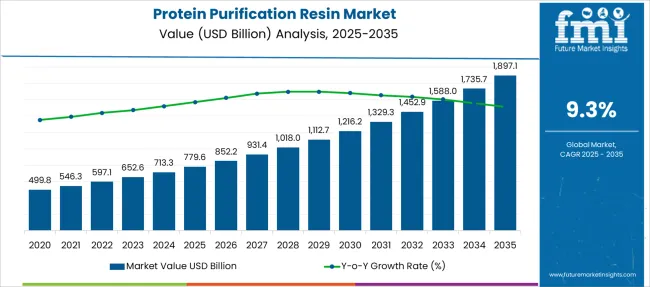
| Metric | Value |
|---|---|
| Protein Purification Resin Market Estimated Value in (2025 E) | USD 779.6 billion |
| Protein Purification Resin Market Forecast Value in (2035 F) | USD 1897.1 billion |
| Forecast CAGR (2025 to 2035) | 9.3% |
The protein purification resin market is experiencing accelerated growth as biotechnological research and development intensifies across therapeutic, diagnostic, and vaccine development pipelines. Increasing demand for high purity biologics, especially monoclonal antibodies and recombinant proteins, is supporting the widespread adoption of advanced chromatography resins.
Regulatory bodies continue to enforce stringent purity standards, prompting manufacturers to invest in reliable and scalable purification solutions. Technological advancements in resin chemistry, ligand specificity, and binding capacity are enhancing downstream processing efficiency.
The global focus on precision medicine and biologics manufacturing is expected to sustain demand across diverse production environments. As bioprocessing becomes more modular and quality centric, the market is anticipated to expand further, driven by its critical role in achieving consistent product quality and compliance.
The market is segmented by Key Industries and Product Categories and region. By Key Industries, the market is divided into Biopharmaceuticals, Academic & Research Institutions, Industrial Biotechnology, and Diagnostics & Life Sciences. In terms of Product Categories, the market is classified into Affinity Chromatography Resins, Ion Exchange Resins, Size-Exclusion Resins, and Hydrophobic Interaction Resins. Regionally, the market is classified into North America, Latin America, Western Europe, Eastern Europe, Balkan & Baltic Countries, Russia & Belarus, Central Asia, East Asia, South Asia & Pacific, and the Middle East & Africa.
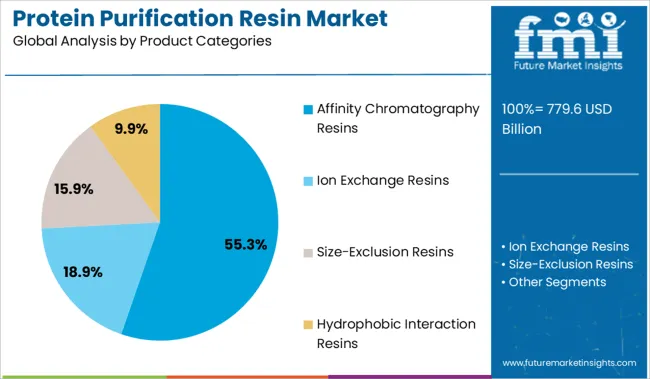
The affinity chromatography resins segment is projected to contribute 55.30% of the total market revenue by 2025 within the product category, establishing itself as the most dominant segment. This position is driven by its superior specificity in isolating target proteins, making it essential for purifying biologics at both research and commercial scales.
The high binding affinity between ligands and target molecules enables exceptional yield and purity, which is especially crucial in monoclonal antibody production. Its ability to streamline purification steps and reduce process time has supported its widespread adoption in biopharmaceutical workflows.
With growing emphasis on process consistency and efficiency in biologics manufacturing, the use of affinity chromatography resins continues to rise, reinforcing its leadership in the product category.
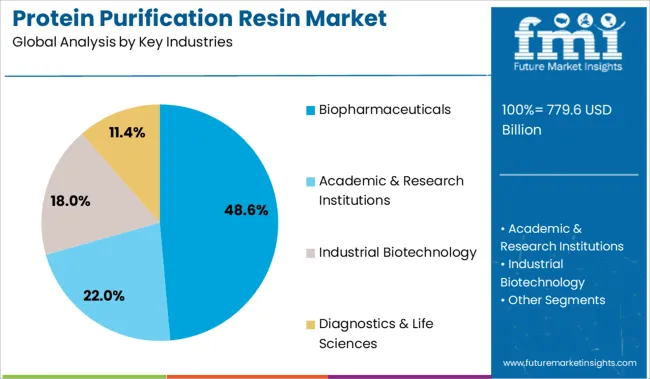
The biopharmaceuticals industry segment is anticipated to hold 48.60% of the total market revenue by 2025, making it the leading end use category. This dominance is attributed to the increasing reliance on protein based therapeutics for treating chronic, autoimmune, and infectious diseases.
The need for high throughput and contamination free purification methods has driven biopharma companies to adopt specialized resins for downstream processing. Additionally, regulatory compliance, scalability, and reproducibility requirements in large scale biologics production have favored the adoption of robust purification resins.
The growth of biosimilars, personalized medicine, and cell and gene therapies is further expanding the footprint of protein purification technologies in the biopharmaceutical sector, solidifying its position as the primary industry contributor.
Governments across the world are actively investing in research and development and setting out initiatives that boost the development and growth of the biotechnology and pharmaceutical markets. The supportive governments are also providing several benefits through grants, tax incentives, and investment-friendly regulations, amongst others.
The demand for the protein purification resin market is higher in the pharmaceutical industry owing to considerable investments in the development of the biomarker-specific molecule. The protein purification resin market is growing owing to lucrative funding from both private and public research organizations for protein research and increasing research in the structural-based drug design field.
Technological advancements such as automated purification instruments and single-use technologies are also fuelling the growth of the protein purification resin market. Also, the increasing trend of Contract Research Organizations (CRO) is creating an upsurge in demand for protein purification resin.
The increasing prevalence of disease and several other health issues has resulted in additional consumption of pharmaceutical products, and this is said to promote the growth of this market during the forecast years.
In the pharmaceutical industry, the most crucial factor is the purity of the protein. The protein purification resin is utilized in the pharmaceutical industry in medium- and small-scale downstream processing. In developing regions, the rate of expansion of the pharmaceutical industry is higher, and this is creating opportunities and will support the global protein purification resin market.
Several protein purification resin manufacturers across the world are constantly inventing and launching novel products which are suitable for varied parameters such as low-pressure to medium-pressure liquid chromatography. The easy accessibility of innovative and novel protein purification resin products is escalating the demand and sales of the products in the global market.
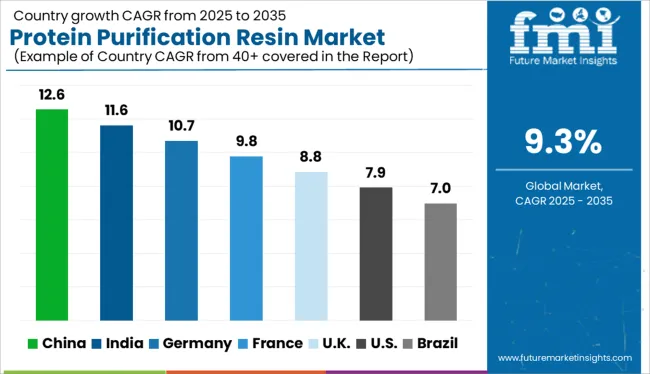
The global protein purification resin market can be divided into seven distinctive regions. In developed nations, rapid industrialization and innovation will continue to drive the sales of protein purification resin expansion.
North America is responsible for the biggest market share of the protein purification resin market followed by Europe. These regions possess strong research and development field and the support from the pharmaceutical industry are backing the increased consumption of protein purification resin in the global market by the countries of these regions.
Also, in North America, the funding for life science research is higher, this region also has the presence of key market players and established research infrastructure. These factors will promote the growth of the protein purification resin market in this region.
Asia Pacific is anticipated to garner the highest growth rate in the global protein purification resin market. This is due to larger research and development activities in this region which will boost the consumption of protein purification resin in the global market. Developing countries such as China and India have increased initiatives undertaken by their governments. Also, the governments of these countries are supporting funds for the development of new and inventive purification methods.
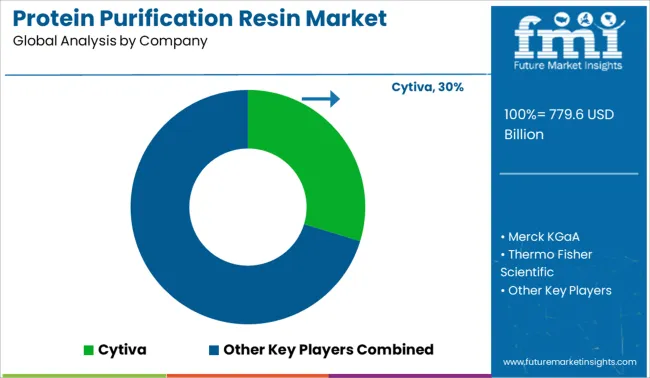
A few global protein purification resin market key players are Promega Corporation, Labome, Pall Corporation, IBA GmbH, Takara Bio Inc., Purolite Life Sciences, BioVision Incorporated, Westburg BV, Roche Holding AG, Sterogene Bioseparations, Expedeon Ltd., Thermo-Fisher Scientific, Mayflower Bioscience, Merck KGaA, Molecular Cloning Laboratories.
These players are using numerous strategies, such as mergers & acquisitions, partnerships, collaborations, etc., to strengthen their market position and augment the sales of protein purification resin. For instance, in February 2025, Merck KGaA which is a leader in science and technology, declared the closure of transactions to acquire Exelead, after the regulatory clearances and execution of other mandatory closing conditions for nearly USD 780 million in cash.
| Report Attribute | Details |
|---|---|
| Growth Rate | CAGR of 9.3% from 2025 to 2035 |
| Base Year for Estimation | 2024 |
| Historical Data | 2020 to 2024 |
| Forecast Period | 2025 to 2035 |
| Quantitative Units | Revenue in USD Million, Volume in Kilotons, and CAGR from 2025 to 2035 |
| Report Coverage | Revenue Forecast, Volume Forecast, Company Ranking, Competitive Landscape, Growth Factors, Trends, and Pricing Analysis |
| Segments Covered | Type, End Use, Distribution Channel |
| Regions Covered | North America; Latin America; Europe; South Asia; East Asia; Oceania; Middle East and Africa |
| Key Countries Profiled | USA, Canada, Brazil, Argentina, Germany, United Kingdom, France, Spain, Italy, Nordics, BENELUX, Australia & New Zealand, China, India, ASIAN, GCC Countries, South Africa |
| Key Companies Profiled | Promega Corporation; Labome; Pall Corporation; IBA GmbH; Takara Bio Inc.; Purolite Life Sciences; BioVision Incorporated; Westburg BV; Roche Holding AG; Sterogene Bioseparations; Expedeon Ltd.; Thermo-Fisher Scientific; Mayflower Bioscience; Merck KGaA; Molecular Cloning Laboratories |
| Customization | Available Upon Request |
The global protein purification resin market is estimated to be valued at USD 779.6 billion in 2025.
The market size for the protein purification resin market is projected to reach USD 1,897.1 billion by 2035.
The protein purification resin market is expected to grow at a 9.3% CAGR between 2025 and 2035.
The key product types in protein purification resin market are biopharmaceuticals, academic & research institutions, industrial biotechnology and diagnostics & life sciences.
In terms of product categories, affinity chromatography resins segment to command 55.3% share in the protein purification resin market in 2025.






Our Research Products

The "Full Research Suite" delivers actionable market intel, deep dives on markets or technologies, so clients act faster, cut risk, and unlock growth.

The Leaderboard benchmarks and ranks top vendors, classifying them as Established Leaders, Leading Challengers, or Disruptors & Challengers.

Locates where complements amplify value and substitutes erode it, forecasting net impact by horizon

We deliver granular, decision-grade intel: market sizing, 5-year forecasts, pricing, adoption, usage, revenue, and operational KPIs—plus competitor tracking, regulation, and value chains—across 60 countries broadly.

Spot the shifts before they hit your P&L. We track inflection points, adoption curves, pricing moves, and ecosystem plays to show where demand is heading, why it is changing, and what to do next across high-growth markets and disruptive tech

Real-time reads of user behavior. We track shifting priorities, perceptions of today’s and next-gen services, and provider experience, then pace how fast tech moves from trial to adoption, blending buyer, consumer, and channel inputs with social signals (#WhySwitch, #UX).

Partner with our analyst team to build a custom report designed around your business priorities. From analysing market trends to assessing competitors or crafting bespoke datasets, we tailor insights to your needs.
Supplier Intelligence
Discovery & Profiling
Capacity & Footprint
Performance & Risk
Compliance & Governance
Commercial Readiness
Who Supplies Whom
Scorecards & Shortlists
Playbooks & Docs
Category Intelligence
Definition & Scope
Demand & Use Cases
Cost Drivers
Market Structure
Supply Chain Map
Trade & Policy
Operating Norms
Deliverables
Buyer Intelligence
Account Basics
Spend & Scope
Procurement Model
Vendor Requirements
Terms & Policies
Entry Strategy
Pain Points & Triggers
Outputs
Pricing Analysis
Benchmarks
Trends
Should-Cost
Indexation
Landed Cost
Commercial Terms
Deliverables
Brand Analysis
Positioning & Value Prop
Share & Presence
Customer Evidence
Go-to-Market
Digital & Reputation
Compliance & Trust
KPIs & Gaps
Outputs
Full Research Suite comprises of:
Market outlook & trends analysis
Interviews & case studies
Strategic recommendations
Vendor profiles & capabilities analysis
5-year forecasts
8 regions and 60+ country-level data splits
Market segment data splits
12 months of continuous data updates
DELIVERED AS:
PDF EXCEL ONLINE
Industry Share Analysis for Protein Purification Resin Companies
Protein Purification and Isolation Market Insights – Size, Share & Forecast 2025 to 2035
Protein A Resins Market Trends, Demand & Forecast 2025 to 2035
Key Companies & Market Share in the Protein A Resins Market
India Protein A Resins Market Insights – Trends, Demand & Forecast 2025-2035
Japan Protein A Resins Market Trends – Size, Share & Growth 2025-2035
China Protein A Resins Market Report – Growth, Trends & Industry Outlook 2025-2035
Germany Protein A Resins Market Analysis – Demand, Innovations & Forecast 2025-2035
United States Protein A Resins Market Trends – Size, Share & Growth 2025-2035
Resin Silencer Market Size and Share Forecast Outlook 2025 to 2035
Resin Capsule Market Forecast and Outlook 2025 to 2035
Protein-Coating Line Market Forecast Outlook 2025 to 2035
Protein Labelling Market Size and Share Forecast Outlook 2025 to 2035
Resin Cement for Luting Market Size and Share Forecast Outlook 2025 to 2035
Protein Puddings Market Size and Share Forecast Outlook 2025 to 2035
Protein/Antibody Engineering Market Size and Share Forecast Outlook 2025 to 2035
Protein Expression Market Size and Share Forecast Outlook 2025 to 2035
Protein Hydrolysate For Animal Feed Application Market Size and Share Forecast Outlook 2025 to 2035
Protein Crisps Market Outlook - Growth, Demand & Forecast 2025 to 2035
Protein Hydrolysate Market Size and Share Forecast Outlook 2025 to 2035

Thank you!
You will receive an email from our Business Development Manager. Please be sure to check your SPAM/JUNK folder too.
Chat With
MaRIA